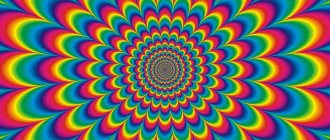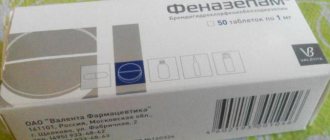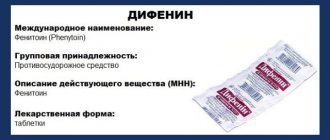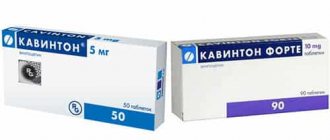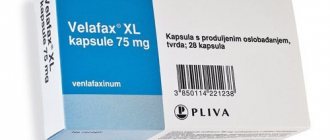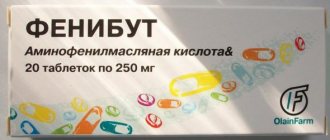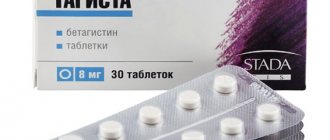| Trazodone | |
| Trazodonum | |
| Trazodone | |
| Chemical compound | |
| IUPAC | 2-(3-[4-(3-chlorophenyl)piperazin-1-yl]propyl)-[1,2,4]triazolo[4,3- a ]pyridin-3(2H ) -one |
| Gross formula | C₁₉H₂₂ClN₅O |
| Molar mass | 371.864 g/mol |
| CAS | 19794-93-5 |
| PubChem | 5533 |
| DrugBank | APRD00533 |
| Classification | |
| ATX | N06AX05 |
| Pharmacokinetics | |
| Bioavailable | high |
| Metabolism | Liver |
| Half-life | 3-6 hours |
| Excretion | 20% feces, 80% urine |
| Dosage forms | |
| pills | |
| Method of administration | |
| orally | |
| Other names | |
| Trittico® | |
| Trazodone at Wikimedia Commons | |
Trazodone
is an antidepressant that belongs to the class of serotonin antagonists/reuptake inhibitors (SSRIs). Along with blocking serotonin reuptake and increasing serotonergic neurotransmission, it strongly blocks serotonin receptors of the 5-HT2 subtype, which explains the low likelihood of sexual side effects, as well as the low likelihood of exacerbation of anxiety, insomnia and nervousness compared to SSRI antidepressants.
Trazodone has relatively little effectiveness compared to most other antidepressants. For severe depression, its effectiveness is usually insufficient [ source not specified 751 days
].
Pharmacological properties
The drug has an antidepressant (thymoleptic) effect, combined with an anxiolytic effect. In terms of pharmacological properties and neurochemical action, it differs from typical antidepressants; does not reduce the depressive effect of reserpine, weakens the central effects of phenamine and the peripheral effect of norepinephrine; does not have a noticeable effect on the neuronal uptake of catecholamines, but selectively blocks the uptake of serotonin and has an α-adrenergic blocking effect [1].
special instructions
Considering the peculiarities of metabolism and the effect of the drug on the body, Trazodone should be prescribed with caution in combination with certain other medications.
- Ritonavir. During clinical trials in healthy patients, it was noted that Ritonavir slows down the half-life of Trazodone and increases the risk of side effects: nausea, fainting, hypotension.
- Other CYP3A4 inhibitors (fluoxetine, ketoconazole). They act similarly to Ritonavir, which belongs to the same group.
- Carbamazepine. Reduces the concentration of the drug in the blood, and therefore Trazodone may not have the desired effect.
- Warfarin. Research is currently underway on their combined use. There are already facts that both drugs mutually influence the concentration of active components in the blood serum, which is confirmed by reviews of scientists published on specialized websites.
- Antihypertensive medications. Caution should be exercised when used together as the risk of hypotension increases.
Reviews from researchers indicate that during treatment with Trazodone it is necessary to monitor general blood counts (leukocytes, blood count), determine the level of liver enzymes, and do an ECG (electrocardiogram). During treatment, it is advisable to refrain from driving vehicles and working with precision machinery.
Pharmacokinetics
Tmax after oral administration is from 0.5 to 2 hours. Taking trazodone with food slows down the rate of absorption from the gastrointestinal tract, reduces Cmax in blood plasma and increases Tmax. Penetrates through histohematic barriers, as well as into tissues and liquids (bile, saliva, breast milk). Plasma protein binding is 87-96%. Metabolized in the liver, the active metabolite is 1-m-chlorophenylpiperazine. T1/2 is 3-6 hours, in the second phase - 5-9 hours. About 75% is subsequently excreted through the kidneys in the urine. About 20% is removed with bile. Complete liberation of the body from the active substance and its metabolites is observed 98 hours after administration.
Drug interactions
A case of the development of ari has been described with the simultaneous use of trazodone with.
A case has been described of a moderately pronounced decrease in the anticoagulant effect of warfarin when used simultaneously with trazodone.
With simultaneous use, it is possible to increase the concentration of digoxin in the blood plasma and develop symptoms of intoxication.
With simultaneous use with a case of increased concentrations of carbamazepine in the blood plasma.
When used simultaneously with lithium salts, tremor and reversible symptoms of neurotoxicity are possible.
When taking pseudoephedrine during therapy with trazodone, a case of developing anxiety, panic, blackout, and depersonalization has been described.
Trazodone is an antidepressant used for various depressive disorders. Its main difference from the classical forms of antidepressants is that it does not belong to the tricyclic or tetracyclic system. The action of the drug as an antagonist of serotonin reuptake and an increaser in neurotransmission is combined with effective blocking of receptors belonging to the 5-HT2 subtype. This explains the low risk of side effects in the sexual sphere and such consequences as increased feelings of anxiety, exacerbation of nervousness and sleep disturbance, although unpleasant manifestations in the form of weakness and drowsiness are not excluded. But the effectiveness of trazodone is inferior to a number of other antidepressants, so its use in severe forms of depression is little justified.
Indications for use
- Anxiety and depressive states of endogenous etiology (including involutional depression);
- psychogenic depression (including reactive and neurotic depression);
- anxiety-depressive states against the background of organic diseases of the central nervous system;
- depressive states with prolonged pain syndrome;
- alcoholic depression;
- benzodiazepine dependence;
- libido and potency disorders[2];
- insomnia, including that occurring during therapy with SSRIs or TCAs[3].
The drug is widely used in the complex treatment of patients with somatic diseases complicated by mental disorders (for example, anxiety).
Trazodone should not be used to treat behavioral and psychological symptoms of dementia[4].
Combination of alcohol and medication Trittico
Is it possible to take medication and alcohol at the same time? During alcohol consumption, blood pressure increases significantly. If you take the drug at the same time, this will help reduce it. That is why, when taking medication and alcohol at the same time, a lack of oxygen level in the blood is quite often observed - hypoxia.
Dizziness
Taking this medication will lead to a sharp deterioration in the person’s health. In most cases, patients experience dizziness. In some cases, patients experienced fainting. If you drink alcohol and an antidepressant at the same time, the first of them will slowly oxidize in the body.
The health of patients deteriorates significantly, they become lethargic. With further consumption of alcoholic beverages, the situation worsens. In some cases, breathing problems may occur, as well as coma. If a person drinks alcohol during treatment, this negatively affects the functioning of the liver and contributes to its destruction.
Dosage regimen
The initial daily dose is up to 200 mg, divided into 3 doses. Depending on the type and severity of depression, and also taking into account the α-adrenergic blocking effect, up to 300 mg per day is prescribed. If absolutely necessary, the dose is increased to 600 mg/day, but in this case it is recommended to take the bulk of the dose before bedtime.
When used as an anxiolytic agent (for neurotic and somatic depression), 25 mg is prescribed 3 times a day.
It is advisable to take Trazodone after a meal or light snack: taking it on an empty stomach, some patients (about 6%) experience dizziness[5].
Parenterally administered in a dose of 50 mg as an anxiolytic agent for premedication before surgery.
Overdose
In case of an overdose, the following may occur: vomiting and nausea, dizziness, poor coordination of movements, drowsiness and weakness, low blood pressure, convulsions and seizures similar to epilepsy . There are also characteristic changes in the electrocardiogram, intensification and an increase in the frequency of adverse reactions, including respiratory arrest.
As therapy, the stomach is washed, forced diuresis , the patient is given activated charcoal or other enterosorbents , supportive treatment is carried out, and life-threatening symptoms are eliminated. The medicine does not have a specific antidote .
Contraindications
- pregnancy;
- lactation period (breastfeeding);
- children under 6 years of age;
- hypersensitivity to the drug.
The drug is prescribed with caution to patients with AV block, myocardial infarction (early recovery period), arterial hypertension (dose adjustment of antihypertensive drugs may be required), ventricular arrhythmia, a history of priapism, renal and/or liver failure, and patients under 18 years of age.
Where to go for it
It is better to purchase the product at the pharmacy, which is confirmed by reviews from doctors. The price of a medicine and its analogues may vary in different regions:
When purchasing from online pharmacies, the price may include delivery by mail or courier fees. Check this information.
It should be remembered that Trazodone is a serious drug that should not be taken without medical prescription. Therefore, no matter how much you want to quickly get rid of erectile dysfunction due to depression, you should not prescribe this medicine yourself.
Ivan, 32 years old:
Due to depression, sexual desire disappeared. After a month of using Tradozone, a good positive effect was observed. I will definitely continue the treatment prescribed by the doctor.
Valery Sergeevich, 47 years old:
The erection disappeared along with any desire to have sex after severe stress, amid the depression that followed. I started taking Tradozone after consulting a doctor and have no regrets. Firstly, after some time, my sex life actually improved, and secondly, the depression subsided. Now I look at things positively.
Sergey Leonidovich, psychotherapist:
Indeed, Trazodone and its analogues can successfully combat erectile dysfunction in men suffering from depression. The drug has long been adopted by specialists at the clinic where I work. The main thing is the right approach to therapy, and then your sex life will improve quickly.
Trazodone is a drug that belongs to the group of antidepressants.
What is the composition and release form of the drug Trazodone?
The pharmaceutical industry produces the drug Trazodone in tablet form, and the tablets have a prolonged effect, they are biconvex, white in color, and there are two marks on both sides of the drug. The active substance is trazodone hydrochloride in an amount of 150 milligrams.
Among the auxiliary components there are the following compounds: sucrose, magnesium stearate, carnauba wax, in addition, povidone. The tablets are packed in blisters. The medicine box has an expiration date on it, after which it is contraindicated to use it.
What is the effect of Trazodone?
The drug Trazodone has an antidepressant effect on the body. The mechanism of action of this medication has not yet been fully elucidated, however, it is known that the active compound of the drug inhibits the reuptake of serotonin and enhances the effects of 5-hydroxytryptophan, which is a precursor of serotonin.
The antidepressant effect of the drug is combined with an anxiolytic (anti-anxiety) effect, as well as a sedative. The drug relieves (suppresses) anxiety, tension and fear, as well as somatic manifestations (excessive sweating, palpitations, frequent urination, headache, and myalgia).
The drug increases sleep duration and depth in patients suffering from depression, and also restores sleep structure. Trazodone reduces the pathological craving for alcohol, in addition, eliminates the depressive and anxiety state during withdrawal syndrome.
The medication is prescribed for concomitant glaucoma, impaired cognitive function, as well as prostate hypertrophy and in old age. The drug is not addictive. Well absorbed from the digestive tract. After about an hour, the maximum concentration is reached. Protein binding - 95%.
The drug passes through histohematic barriers. Trazodone is metabolized in the liver, resulting in the formation of m-chlorophenylpiperazine, which is an active metabolite. The half-life is biphasic. Excreted with bile and through the kidneys.
What are the indications for use of the drug Trazodone?
Trazodone is indicated for use in the following situations:
For various depressive states, accompanied by severe tension and anxiety; Prescribe the drug in the presence of pain due to neuralgia; For agoraphobia (fear of open space); Alcohol withdrawal state; If you have a drug addiction to benzodiazepines.
In addition, an antidepressant is used for impotence, as well as decreased libido.
What are the contraindications for use of Trazodone?
I will list the situations in which Trazodone is not used, they are as follows:
Do not use the medicine if you are hypersensitive to its components; With extrasystole; With myocardial infarction; The medication is not prescribed until the age of six; If ventricular arrhythmia is detected; With tachycardia; With liver or kidney failure.
The drug is prescribed with caution for arterial hypertension, in addition, if there is a history of priapism, as well as before the age of eighteen.
What are the uses and dosage of Trazodone?
The drug Trazodone is prescribed orally, with the initial dosage being 50 or 100 mg, the tablets are taken once a day, preferably before bedtime; if necessary, the doctor can increase the amount of the drug by 50 mg/day every three days until the required therapeutic effect is achieved.
The maximum daily dosage of Trazodone should not exceed 450 milligrams on an outpatient basis; when treatment is carried out in a hospital, the dose of the drug can be increased to 600 mg.
What are the side effects of Trazodone?
I will list the main side effects: fatigue, weakness, psychosis, headache, drowsiness, dizziness, insomnia, agitation, possible hallucinations, tremors, hypotension, muscle twitching, paresthesia, seizures, blurred vision is possible, in addition, confusion, as well as double vision.
Other negative manifestations: orthostatic hypotension, atrial fibrillation, increased appetite, arrhythmia, hemolytic anemia, unpleasant taste in the mouth, methemoglobinemia, in addition, nausea, vomiting, premature menstruation, as well as flatulence and other symptoms.
Overdose from Trazodone
In case of an overdose of an antidepressant drug, the following symptoms are possible: decreased blood pressure, nausea, vomiting, drowsiness, dizziness, loss of coordination, in addition, so-called epileptiform seizures, and respiratory arrest is not excluded.
In such a situation, the patient’s stomach is washed, forced diuresis is performed, in addition, activated charcoal is prescribed, and symptomatic therapy is also indicated.
Special conditions
During treatment with Trazodone, a general blood test should be taken from the patient in order to detect leukopenia or neutropenia; in addition, it is advisable to conduct an ECG in patients with cardiac pathology.
How to replace Trazodone, what analogues?
Analogue drugs include Azona, in addition, Trittico.
Conclusion
We have reviewed the drug Trazodone and instructions for use. Antidepressants should be taken only as prescribed by a specialist, adhering to the prescribed dosage of the medication.
The patient must independently study the instructions for use of the prescribed drug. Be healthy!
Formula:
C19H22ClN5O, chemical name: 2-propyl]-1,2,4-triazolopyridin-3(2H)-one (as hydrochloride).
Pharmacological group:
neurotropic drugs/antidepressants.
Pharmacological action:
antidepressant.
Pharmacological properties
The mechanism of action of trazodone has not been fully elucidated. Trazodone is characterized by a pronounced affinity for some subtypes of serotonin receptors. Trazodone selectively inhibits the reuptake of serotonin by synapses in the brain, potentiates the effects of 5-hydroxytryptophan (a precursor of serotonin), reduces the sensitivity of beta-adrenergic receptors and has a slight effect on the neuronal uptake of dopamine and norepinephrine and on alpha-adrenergic receptors; MAO does not inhibit. Trazodone has almost no anticholinergic effect, but can suppress or reduce salivation (especially in elderly and middle-aged patients). The antidepressant effect of trazodone is combined with anxiolytic and sedative effects. Trazodone relieves symptoms of anxiety, both mental (fear, affective tension, insomnia) and somatic (headache, palpitations, myalgia, increased sweating, frequent urination). Trazodone increases the duration and depth of sleep in depressed patients and restores the physiological structure of sleep. Trazodone reduces pathological craving for alcohol. For withdrawal syndrome in patients with benzodiazepine dependence, trazodone eliminates sleep disturbances and anxiety-depressive states (benzodiazepines can be completely replaced by trazodone during remission). Trazodone helps restore potency and libido. Trazodone can be used for concomitant cognitive impairment, prostatic hypertrophy, glaucoma, as well as in elderly patients, but in the latter, hypotensive and sedative effects are more often observed. Trazodone is not addictive. Therapeutic effects in some patients (according to clinical trials) were observed by the end of the first week of therapy, in 75% of patients - at the end of the second week, in 25% - after 2 - 4 weeks.
Trazodone is well absorbed from the gastrointestinal tract. After 1 hour, the maximum concentration in the blood plasma is reached. Taking the drug during or immediately after a meal increases its absorption, but reduces the maximum concentration, lengthening the time to reach it to 2 hours. Trazodone is bound to plasma proteins by 89–95%. Trazodone passes through tissue barriers (including the blood-brain barrier). Trazodone is metabolized in the liver to form the active metabolite m-chlorophenylpiperazine. The half-life of trazodone has two phases: the duration of the early phase is 3–6 hours, the late phase is 5–9 hours; In some patients, accumulation of trazodone is possible. The drug is excreted within 98 hours after its administration in the urine (75%, including 70% in the form of inactive metabolites) and bile (20%). There is information about the effectiveness of trazodone for kleptomania, bulimia, panic attacks, phobias (including agoraphobia), acute withdrawal syndrome in alcoholism, pain syndrome in diabetic neuropathy and other types of chronic pain, and for the prevention of migraines.
Indications
Depressive states of various origins (psychotic, endogenous, somatogenic, neurotic and others) with severe tension and anxiety; agoraphobia, neuralgia pain syndrome, benzodiazepine drug dependence, alcohol withdrawal state, impotence, decreased libido.
Method of administration of trazodone and dose
Trazodone is taken orally. Adults: the initial dose is 50–100 mg once before bedtime, the dose is increased, if necessary, by 50 mg every 3–4 days until a therapeutic effect is achieved. The maximum daily dose in outpatient settings is 450 mg, in inpatient settings it is 600 mg. For weakened and elderly patients, the initial dose is up to 100 mg per day, which can be increased, if necessary, to 300 mg per day. Children 6 – 18 years old: 1.5 – 2 mg/kg per day, the dose is increased, if necessary, to 6 mg/kg per day.
Libido disorders: 50 mg per day. Impotence: 200 mg per day in monotherapy, 50 mg per day as part of complex treatment. Benzodiazepine dependence: stepwise reducing the dose of benzodiazepines by 0.25 or 0.5 tablets, adding 50 mg of trazodone together for 3 weeks, then continue to reduce the dose of benzodiazepines until complete abolition, then reduce the dose of trazodone by 50 mg per day every 3 weeks. When treating with trazodone, it is necessary to regularly conduct a general blood test (for timely detection of blood changes); ECG monitoring is desirable in patients with diseases of the circulatory system. Careful monitoring of patients with suicidal tendencies is necessary, especially in the first weeks of therapy. With the development of severe neutro- and leukopenia, priapism, treatment is immediately canceled; in other cases, trazodone should be withdrawn gradually. Alcohol intake should be avoided during trazodone therapy. Trazodone should be used with caution by vehicle drivers during work and by people whose activities involve increased concentration.
Contraindications for use
Hypersensitivity, ventricular arrhythmia, myocardial infarction (early recovery period), tachycardia, extrasystole, renal and/or liver failure, age up to 6 years.
Restrictions on use
History of priapism, arterial hypertension (dose adjustment of antihypertensive drugs may be required), age under 18 years. Etc
use during pregnancy and breastfeeding
Do not use trazodone in women during pregnancy. Animal studies have shown that trazodone in doses 30 to 50 times the MRDC increases the incidence of fetal resorption and causes congenital malformations. Breastfeeding should be discontinued during trazodone therapy. Trazodone with its metabolites is found in the milk of lactating rats. It is not known whether trazodone is excreted in women's breast milk.
Side effects of trazodone
Sense organs and nervous system:
fatigue, headache, weakness, dizziness, drowsiness, insomnia, agitation, hypomania, psychosis, hallucinations, muscle twitching, tremor, aphasia, grand mal seizures, akathisia, ataxia, dyskinesia, confusion, paresthesia, syncope, diplopia, blurred vision;
blood and circulatory system:
arterial hypotension (including orthostatic), arrhythmias (including ectopic ventricular rhythms, tachycardia and bradycardia), atrial fibrillation, congestive heart failure, leukopenia or leukocytosis, neutropenia (usually minor), methemoglobinemia, hemolytic anemia;
digestive system:
increased appetite, unpleasant taste and dry mouth, caries, hypersalivation, diseases of the periodontal tissues, nausea, oral candidiasis, vomiting, diarrhea, flatulence, constipation, increased levels of amylase and bilirubin in the blood plasma, cholestasis, jaundice;
genitourinary system:
urinary retention, hematuria, increased urination, premature menstruation, increased libido, hirsutism, priapism, retrograde ejaculation, impotence;
allergic reactions:
urticaria, skin rash;
other:
chest pain, myalgia, alopecia, edema, psoriasis.
Interaction of trazodone with other substances
Trazodone, unlike typical antidepressants, does not reduce the depressive effects of reserpine; it weakens the peripheral effect of norepinephrine and the central effect of amphetamine. Trazodone enhances the effects of drugs that depress the central nervous system (including tricyclic antidepressants, barbiturates, clonidine, antihistamines, alcohol), as well as muscle relaxants and anticholinergics. When trazodone is used together with antihypertensive drugs, the possibility of developing orthostatic hypotension increases. Trazodone weakens the effects of psychostimulants. Trazodone increases the levels of phenytoin and digoxin in the blood plasma. Do not use trazodone in combination with MAO inhibitors. When ritonavir and trazodone are used together, a dose reduction of the latter may be necessary. Patients taking trazodone and carbamazepine together should be under close medical supervision. When trazodone is combined with potent CYP3A4 inhibitors, the dose should be reduced.
Overdose
In case of an overdose of trazodone, nausea, drowsiness, vomiting, dizziness, loss of coordination, decreased blood pressure, priapism, epileptiform seizures, respiratory arrest, ECG changes, and worsening of adverse reactions develop. Necessary: gastric lavage, intake of activated carbon, forced diuresis, maintenance of vital functions, symptomatic treatment; There is no specific antidote.
Side effect
From the central nervous system and peripheral nervous system: excessive sedation[6], lethargy[5], anxiety, derealization, agitation, cognitive impairment[7], fatigue, drowsiness, confusional states (rarely)[8], headache, dizziness, weakness, incoordination, paresthesia, disorientation, tremor.
From the cardiovascular system: decreased blood pressure [8]; orthostatic hypotension[6] (especially in people with vasomotor lability) caused by the adrenolytic effect of the drug; arrhythmia[6] (the ability to cause isolated premature contractions of the ventricles and short episodes (3-4 beats) of ventricular tachycardia[5]), conduction disturbances, bradycardia.
From the hematopoietic system: leukopenia and neutropenia (usually mild).
From the digestive system: dryness and bitterness in the mouth, nausea and vomiting[6], diarrhea, loss of appetite.
Other: allergic reactions, eye irritation, myalgia, anorgasmia, priapism [8] (patients who experience this side effect should immediately stop taking the drug and consult a doctor), serotonin syndrome [7].
